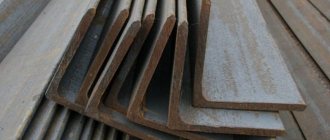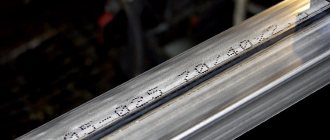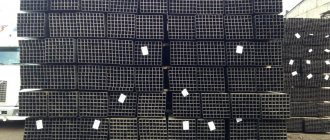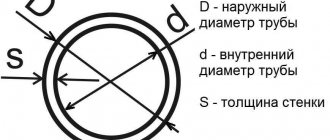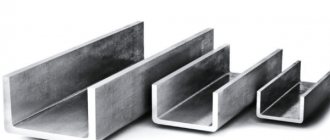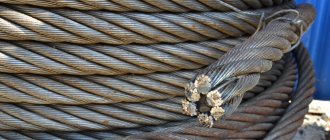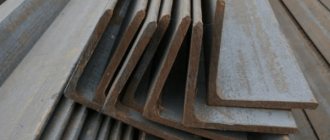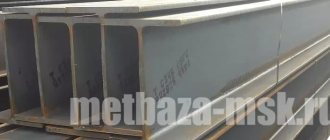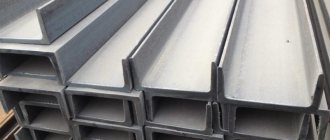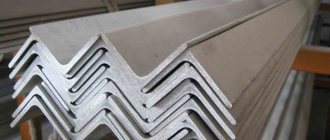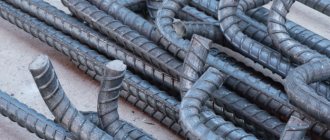Assortment
Hot-rolled steel sections for different purposes.
Dimensions GOST
5157-83
OKP 09 3053
Date of introduction 01/01/85
1. This standard establishes a range of hot-rolled steel profiles: for oblique washers, oval, for sickles, for skates, segmented, for brake tires, used in various industries.
2. Profile dimensions, maximum dimensional deviations, cross-sectional area, weight of 1 m length must correspond to those indicated in Figures 1-6 and Tables 1-5.
4
/G
<-
Damn.1
2.1. Profile for oblique washers
| 2B | IN | n | h | Square transverse sections, cm2 | Theoretical | For bolts | |||
| Nom. | Prev. off | Nom. | Prev. OFF | Nom. | Prev. OFF | Nom. | Prev. OFF | mass, 1 m, kg | with thread diameter |
| 32 | +0,5 | 16 | 5,8 | 4 | 1,56 | 1,22 | 8 | ||
| -1,0 | |||||||||
| 40 | 20 | 6,2 | +0,3 -0,5 | 4 | +0,3 -0,5 | 2,04 | 1,60 | 10 | |
| 60 | +0,5 -1,2 | 30 | ±1,0 | 7,3 | 4 | 3,42 | 2,68 | 12-14 | |
| 80 | +0,5 | 40 | 8,4 | 4 | 4,96 | 3,89 | 16-20 | ||
| -1,4 |
(Changed edition, Amendment No. 1).
Official publication
ABOUT
Reproduction is prohibited
Characteristics of the main profiles of the assortment
The primary element of steel structures is rolled steel, which is smelted in metallurgical plants. Rolled steel used in steel structures is divided into two groups: rolled sheet steel (Fig. 3.1, a
) - thin-sheet, thick-sheet, broadband, universal and expanded metal;
profile steel (Fig. 3.1, b
) - angles, channels, I-beams, T-beams, pipes, etc. The availability of assortments of finished rolled profiles at factories ensures the industrial production of structures.
The list of rolled profiles indicating the shape, geometric characteristics, weight per unit length, tolerances and delivery conditions is called assortment.
Fig. 3.1. Main types of profiles
Rolled products (sheets, shapes) are supplied in batches. The batch consists of rolled products of one size, one melting ladle and one heat treatment mode. When checking the quality of metal, any two samples are taken from a batch. Rolled products are supplied both in hot-rolled and heat-treated states.
The variety of types of profiles included in the assortment, frequent gradation of sizes of one type of profile ensures economic design of structures with the possibility of creating a variety of structural forms.
The cost of different profiles is different. The cheapest are sheet steel, rolled I-beams and channels, which stimulates their widespread use. The use of a wide variety of profiles in the design increases the amount of work in metal structures factories for sorting, storing, transporting, straightening profiles, etc. In order to reduce the amount of work in the manufacture of structures, reduced assortments have been introduced, compiled for the design of building structures from the most commonly used and economical profiles.
Metal structural elements (beams, columns, trusses, etc.) manufactured in factories are assembled at construction sites into structural complexes - structures.
Consideration of various criteria for the efficiency of a profile when working in bending and compression showed that the decisive role is played by the “thin-walledness” of the profile - the ratio of its height to its thickness, the larger it is, the more economical the profile. For rolled profiles, rolling technology limits the wall thickness to 4-6 mm, therefore the use of thin-walled welded beams for bending elements, as well as bent-welded box profiles for compressed elements, is more effective than the use of rolled profiles, since the wall thickness in them is not limited by rolling.
Sheet steel
Sheet steel is widely used in construction, supplied in bags, rolls and classified as follows.
Thick sheet steel (GOST 19903-74). The range of this steel includes sheets with thicknesses from 4 mm to 160 mm, widths from 600 mm to 3800 mm. The most popular width is up to 2400 mm. Hot rolled steel sheets are supplied in sheets with a length of 6-12 m and a thickness of up to 160 mm or in rolls with a thickness of 1.2 to 12 mm and a width of 500...2200 mm. Sheets with a thickness of 6 to 12 mm have a thickness gradation of 1 mm, then 2; 3 and 5 mm. Thick steel is widely used in sheet structures, in elements of solid systems (beams, columns, frames, etc.).
Thin sheet steel up to 4 mm is rolled by cold and hot methods. Cold-rolled steel (GOST 19904-90) is much more expensive than hot-rolled steel (GOST 19903-74). Thin sheet steel is used in the manufacture of bent and stamped thin-walled profiles, for roofing coverings, etc. Profiled decking is made from cold-rolled, galvanized, rolled steel.
broadband steel (GOST 82-70) has smooth edges due to rolling between four rolls. Steel thickness is from 6 to 60 mm, width from 200 to 1050 mm and length from 5 to 12 m. The use of universal steel reduces the labor intensity of manufacturing structures, since cutting and smoothing edges by gouging is not required.
Corrugated steel (GOST 8568-77) and expanded (GOST 8706-58) are used for walking platforms.
Angle profiles
Angle profiles are rolled in the form of equal (GOST 8509-86) and unequal (GOST 8510-86) corners (see Fig. 3.1, b
). The range of corners is very diverse: from very small profiles with a cross-sectional area of 1-1.5 cm² to powerful profiles with a cross-sectional area of 140 cm². The corner shelves have parallel edges, which makes design easier. Angles are widely used in lightweight through-frame structures. Working rods from angles are usually arranged into symmetrical sections of two or four angles (Fig. 3.2.). Corners with smaller shelf thicknesses are more economical. Compressed cross-section rods are more stable, especially those made from thin angles. In rods with holes for bolts, the thinner the flanges, the smaller the weakening of the section by holes.
Channels
Geometric characteristics of the channel cross-section (see Fig. 3.1, c
,
g
) are determined by its number, which corresponds to the height of the channel wall
Fig. 3.2. Arrangement of sections of rods from rolled profiles
(in cm). The assortment (GOST 8240-89) includes channels from No. 5 to No. 40 with a slope of the internal edges of the shelves (see Appendix 16, Table 5). However, the slope of the internal edges of the shelves makes design difficult. GOST includes
channels with parallel flange edges, the sections of which have the best design characteristics relative to the x
and
y
, as they simplify bolting to the shelves. Channels are used in powerful core structures (bridges, long-span trusses, etc.), as well as in columns, ties and roof purlins.
Rods from channels operating on axial force are arranged to be rigid relative to the x
and
y
symmetrical sections (Fig. 3.2,
b
).
I-beams
I-beams - the main beam profile - have the greatest variety of types (see Fig. 3.1, Ms.
) that correspond to specific areas of application.
Ordinary I-beams (GOST 8239-89), like channels, have a slope of the internal edges of the flanges and are designated by a number corresponding to their height in cm (Fig. 3.1, d
).
The assortment includes profiles from No. 10 to No. 60 (see Appendix 1, Table 3). The walls of large I-beams have a minimum thickness and, according to stability conditions, reach 1/55 of the height of the I-beam. The thinner the wall, the more favorable the cross-section of the beam when working in bending. However, according to the conditions of rolling technology, the walls of most I-beams are much thicker than required for their stability. Due to the concentration of material in the flanges, I-beams have greater rigidity relative to the x
, but the small width of the flanges makes them unstable relative to the
y
. I-beams are used in bending elements (beams), as well as in branches of lattice columns and various supports, where composite sections are used for their stability (Fig. 3.2, c).
Wide-flange I-beams (GOST 26020-81) have parallel flange edges (see Fig. 3.1, d
).
Wide-flange I-beams are rolled in three types: normal I-beams (B), wide-flange I-beams (W), column I-beams (K). The height of the beam profiles (B) reaches 1000 mm, (W) - 700 and (K) - 400 mm with a ratio of shelf width to height from (at low heights) to (at high heights). Column profiles (K) have a shelf width to height ratio of close to 1:1, which gives them stability relative to the y
.
Structural advantages (parallelism of the edges of the flanges and the thickness of the sections) make it possible to use wide-flange I-beams as an independent element (beams, columns, rods of heavy trusses) that do not require almost any processing, which reduces the labor intensity of manufacturing structures by 2-3 times.
From wide-flange I-beams, by cutting the wall in the longitudinal direction, T-profiles (BT), (ShT) and (KT) are obtained (see Fig. 3.1, d
) convenient for use in lattice structures. As the production of wide-flange I-beams expands, the use of ordinary I-beams is decreasing.
The development of automatic welding creates favorable conditions for the production of welded I-beams from universal steel according to a certain assortment, which makes it possible to use them in the same way as rolled ones (Fig. 3.1, f
).
Thin-walled profiles
Thin-walled I-beams (TU 14-2-205-76) and channels (TN 14-2-204-76) (see Fig. 3.1, g
) are rolled on a continuous mill with especially thin walls and flanges, which makes them 14-20% more economical than conventional rolling profiles. Thin-walled profiles have heights from 120 to 300 mm and shelves with parallel edges. Thin-walled profiles are used in platform beams, half-timbers, light floors and coverings.
Pipes
Steel pipes used in construction are round - hot-rolled (GOST 8732-78 as amended) and electric-welded (GOST 10704-76) (see Fig. 3.1, h
). Tubular profiles are especially economical when used in compressed elements due to the largest radius of gyration for a given cross-sectional area.
Hot-rolled seamless pipes have a diameter from 25 to 550 mm with a wall thickness from 2.5 to 75 mm. These pipes are mainly used in radio and television tower structures.
Round electric-welded pipes have a diameter from 8 to 1420 mm with a wall thickness from 1 to 16 mm. These pipes are used in pipelines, radio and television support elements and coating structures, especially in buildings with aggressive environments.
Cold formed profiles
Bent profiles are made from sheet, tape or strip with a thickness of 1 to 8 mm and can have a wide variety of shapes (Fig. 3.3). The most common are equal-flange angles (GOST 19771-74), unequal-flange angles (GOST 19772-74), channels (GOST 8278-83), bent-welded closed profiles of square (TU 36-2287-80) and rectangular (TU 36-2286-80
with modified sections and galvanized profiled decking (GOST 24045-86). The main area of application of these profiles is lightweight construction of building coverings, where, replacing rolled profiles, they can save up to 10% of metal.
Rice. 3 3. Types of bent profiles
The primary element of steel structures is rolled steel, which is smelted in metallurgical plants. Rolled steel used in steel structures is divided into two groups: rolled sheet steel (Fig. 3.1, a
) - thin-sheet, thick-sheet, broadband, universal and expanded metal;
profile steel (Fig. 3.1, b
) - angles, channels, I-beams, T-beams, pipes, etc. The availability of assortments of finished rolled profiles at factories ensures the industrial production of structures.
The list of rolled profiles indicating the shape, geometric characteristics, weight per unit length, tolerances and delivery conditions is called assortment.
Fig. 3.1. Main types of profiles
Rolled products (sheets, shapes) are supplied in batches. The batch consists of rolled products of one size, one melting ladle and one heat treatment mode. When checking the quality of metal, any two samples are taken from a batch. Rolled products are supplied both in hot-rolled and heat-treated states.
The variety of types of profiles included in the assortment, frequent gradation of sizes of one type of profile ensures economic design of structures with the possibility of creating a variety of structural forms.
The cost of different profiles is different. The cheapest are sheet steel, rolled I-beams and channels, which stimulates their widespread use. The use of a wide variety of profiles in the design increases the amount of work in metal structures factories for sorting, storing, transporting, straightening profiles, etc. In order to reduce the amount of work in the manufacture of structures, reduced assortments have been introduced, compiled for the design of building structures from the most commonly used and economical profiles.
Metal structural elements (beams, columns, trusses, etc.) manufactured in factories are assembled at construction sites into structural complexes - structures.
Consideration of various criteria for the efficiency of a profile when working in bending and compression showed that the decisive role is played by the “thin-walledness” of the profile - the ratio of its height to its thickness, the larger it is, the more economical the profile. For rolled profiles, rolling technology limits the wall thickness to 4-6 mm, therefore the use of thin-walled welded beams for bending elements, as well as bent-welded box profiles for compressed elements, is more effective than the use of rolled profiles, since the wall thickness in them is not limited by rolling.
Sheet steel
Sheet steel is widely used in construction, supplied in bags, rolls and classified as follows.
Thick sheet steel (GOST 19903-74). The range of this steel includes sheets with thicknesses from 4 mm to 160 mm, widths from 600 mm to 3800 mm. The most popular width is up to 2400 mm. Hot rolled steel sheets are supplied in sheets with a length of 6-12 m and a thickness of up to 160 mm or in rolls with a thickness of 1.2 to 12 mm and a width of 500...2200 mm. Sheets with a thickness of 6 to 12 mm have a thickness gradation of 1 mm, then 2; 3 and 5 mm. Thick steel is widely used in sheet structures, in elements of solid systems (beams, columns, frames, etc.).
Thin sheet steel up to 4 mm is rolled by cold and hot methods. Cold-rolled steel (GOST 19904-90) is much more expensive than hot-rolled steel (GOST 19903-74). Thin sheet steel is used in the manufacture of bent and stamped thin-walled profiles, for roofing coverings, etc. Profiled decking is made from cold-rolled, galvanized, rolled steel.
broadband steel (GOST 82-70) has smooth edges due to rolling between four rolls. Steel thickness is from 6 to 60 mm, width from 200 to 1050 mm and length from 5 to 12 m. The use of universal steel reduces the labor intensity of manufacturing structures, since cutting and smoothing edges by gouging is not required.
Corrugated steel (GOST 8568-77) and expanded (GOST 8706-58) are used for walking platforms.
Angle profiles
Angle profiles are rolled in the form of equal (GOST 8509-86) and unequal (GOST 8510-86) corners (see Fig. 3.1, b
). The range of corners is very diverse: from very small profiles with a cross-sectional area of 1-1.5 cm² to powerful profiles with a cross-sectional area of 140 cm². The corner shelves have parallel edges, which makes design easier. Angles are widely used in lightweight through-frame structures. Working rods from angles are usually arranged into symmetrical sections of two or four angles (Fig. 3.2.). Corners with smaller shelf thicknesses are more economical. Compressed cross-section rods are more stable, especially those made from thin angles. In rods with holes for bolts, the thinner the flanges, the smaller the weakening of the section by holes.
Channels
Geometric characteristics of the channel cross-section (see Fig. 3.1, c
,
g
) are determined by its number, which corresponds to the height of the channel wall
Fig. 3.2. Arrangement of sections of rods from rolled profiles
(in cm). The assortment (GOST 8240-89) includes channels from No. 5 to No. 40 with a slope of the internal edges of the shelves (see Appendix 16, Table 5). However, the slope of the internal edges of the shelves makes design difficult. GOST includes
channels with parallel flange edges, the sections of which have the best design characteristics relative to the x
and
y
, as they simplify bolting to the shelves. Channels are used in powerful core structures (bridges, long-span trusses, etc.), as well as in columns, ties and roof purlins.
Rods from channels operating on axial force are arranged to be rigid relative to the x
and
y
symmetrical sections (Fig. 3.2,
b
).
I-beams
I-beams - the main beam profile - have the greatest variety of types (see Fig. 3.1, Ms.
) that correspond to specific areas of application.
Ordinary I-beams (GOST 8239-89), like channels, have a slope of the internal edges of the flanges and are designated by a number corresponding to their height in cm (Fig. 3.1, d
).
The assortment includes profiles from No. 10 to No. 60 (see Appendix 1, Table 3). The walls of large I-beams have a minimum thickness and, according to stability conditions, reach 1/55 of the height of the I-beam. The thinner the wall, the more favorable the cross-section of the beam when working in bending. However, according to the conditions of rolling technology, the walls of most I-beams are much thicker than required for their stability. Due to the concentration of material in the flanges, I-beams have greater rigidity relative to the x
, but the small width of the flanges makes them unstable relative to the
y
. I-beams are used in bending elements (beams), as well as in branches of lattice columns and various supports, where composite sections are used for their stability (Fig. 3.2, c).
Wide-flange I-beams (GOST 26020-81) have parallel flange edges (see Fig. 3.1, d
).
Wide-flange I-beams are rolled in three types: normal I-beams (B), wide-flange I-beams (W), column I-beams (K). The height of the beam profiles (B) reaches 1000 mm, (W) - 700 and (K) - 400 mm with a ratio of shelf width to height from (at low heights) to (at high heights). Column profiles (K) have a shelf width to height ratio of close to 1:1, which gives them stability relative to the y
.
Structural advantages (parallelism of the edges of the flanges and the thickness of the sections) make it possible to use wide-flange I-beams as an independent element (beams, columns, rods of heavy trusses) that do not require almost any processing, which reduces the labor intensity of manufacturing structures by 2-3 times.
From wide-flange I-beams, by cutting the wall in the longitudinal direction, T-profiles (BT), (ShT) and (KT) are obtained (see Fig. 3.1, d
) convenient for use in lattice structures. As the production of wide-flange I-beams expands, the use of ordinary I-beams is decreasing.
The development of automatic welding creates favorable conditions for the production of welded I-beams from universal steel according to a certain assortment, which makes it possible to use them in the same way as rolled ones (Fig. 3.1, f
).
Thin-walled profiles
Thin-walled I-beams (TU 14-2-205-76) and channels (TN 14-2-204-76) (see Fig. 3.1, g
) are rolled on a continuous mill with especially thin walls and flanges, which makes them 14-20% more economical than conventional rolling profiles. Thin-walled profiles have heights from 120 to 300 mm and shelves with parallel edges. Thin-walled profiles are used in platform beams, half-timbers, light floors and coverings.
Pipes
Steel pipes used in construction are round - hot-rolled (GOST 8732-78 as amended) and electric-welded (GOST 10704-76) (see Fig. 3.1, h
). Tubular profiles are especially economical when used in compressed elements due to the largest radius of gyration for a given cross-sectional area.
Hot-rolled seamless pipes have a diameter from 25 to 550 mm with a wall thickness from 2.5 to 75 mm. These pipes are mainly used in radio and television tower structures.
Round electric-welded pipes have a diameter from 8 to 1420 mm with a wall thickness from 1 to 16 mm. These pipes are used in pipelines, radio and television support elements and coating structures, especially in buildings with aggressive environments.
Cold formed profiles
Bent profiles are made from sheet, tape or strip with a thickness of 1 to 8 mm and can have a wide variety of shapes (Fig. 3.3). The most common are equal-flange angles (GOST 19771-74), unequal-flange angles (GOST 19772-74), channels (GOST 8278-83), bent-welded closed profiles of square (TU 36-2287-80) and rectangular (TU 36-2286-80
with modified sections and galvanized profiled decking (GOST 24045-86). The main area of application of these profiles is lightweight construction of building coverings, where, replacing rolled profiles, they can save up to 10% of metal.
Rice. 3 3. Types of bent profiles
2.2. (Deleted, Amendment No. 1).
2.3. Profile for sickles
•h
Crap. 3* **
| A | b | With | Cross-sectional area, cm2 | Theoretical weight, 1 m, kg | |
| Nom. | Prev. off | Nom. | Prev. OFF | Nom. | Prev. OFF |
| 23 | 3 | 1 | 0,46 | 0,36 | |
| ±1,0 | ±0,5 | ±0,5 | |||
| 32 | 3 | 1 | 0,64 | 0,51 |
